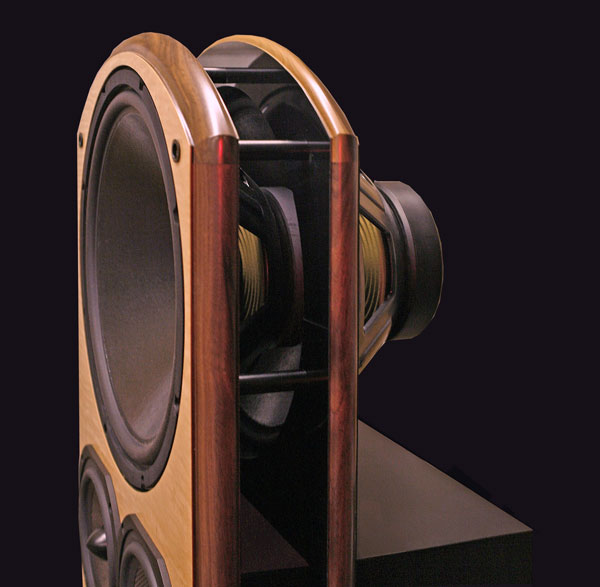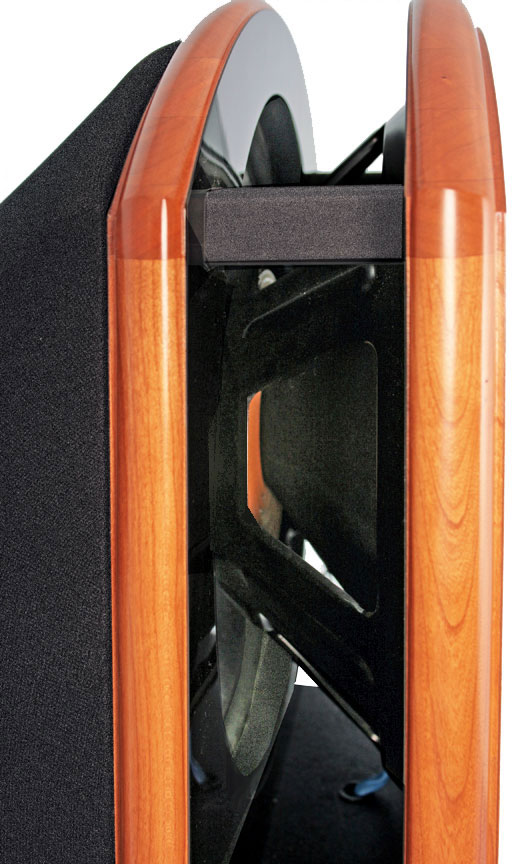Somewhere along the line there is the “What if…,” person.
Things tend to get done the same way to the point of entrenchment, a seemingly unshakable similitude. It’s no different for audiophiles who routinely assemble source, amplification and speakers, stringing them together with cables. Then someone gets the idea, “What if…,” and with that vision a new reality is conceived. It can be dangerous when a couple of people with the right connections share a “What if…” revelation.
I met Bill Dudleston and Doug Brown of Legacy Audio back in 2007 when I wrote up the Focus HD speaker. That was followed by an assessment of the Helix, Legacy’s top-of-the-line, actively crossed system, and an update on the Focus SE. A couple years later I was itching to try something different in reviewing. Legacy granted my wish and developed the speaker I envisioned, a speaker capable of being set up for active or passive crossovers. Let’s call it the ultimate “Crossover Speaker”.
What’s A Crossover Speaker?
To neophytes that might not mean much, but to some who have been in the HiFi game a while it’s a tantalizing concept. Historically, there have been skirmishes in the audio community about the efficacy of cabling, whether digital sound can be as good as analogue, etc. So also there has been a strong difference of opinion between those who use traditional speakers containing internal crossovers driven by a full-range amplifier level signal, and those espousing outboard, either “passive”, meaning not powered, or “active”, indicating powered, crossovers feeding filtered frequencies to dedicated amp channels for dedicated driver sets in the speakers.
The external crossover crowd insists that the standard setup is wrong; better sound is obtained when the crossover has an “out of body experience” from the speakers. Hearing such systems has at times felt like an out of body experience. Well, that’s a bit of an exaggeration, but they can sound quite good. One of my favorites at recent shows, the Lotus Group Granada speaker, uses an actively Bi-amped digital crossover – a similar concept as utilized with the Legacy Audio DSW. Supposedly, such a design confers upon it a serious advantage over passively crossed speakers. One reason the sound of the Granada is fawned over is found in its active crossover. A smaller but highly knowledgeable segment of home audio manufacturers and enthusiasts have concluded that if the outboard crossover is good enough for professional audio applications, then it’s certainly good enough for the home. A fair number of manufacturers of speakers would make active crossover designs, but they fear the marketplace will not support them. They stick with the passive crossover because they know they can sell it; their superior technology sits while the more marketable one thrives.
Is the external crossover really a superior solution? What if someone had a speaker which could “switch hit”? What if one could use a speaker capable of being switched from external to internal crossovers? What if the system synergy between components trumps the use of an outboard crossover? What ifit doesn’t? Those were some of my questions yearning to be answered as I approached Legacy with my idea. To my surprise and delight both Doug and Bill relished the idea; these are “What if,” kind of guys as well. A new Legacy Audio concept speaker was born – the Whisper DSW.
I hadn’t paid much attention to the name on the Owner’s Manual initially as the installation was intensive. Two days later as I read through it, I couldn’t figure out why it was named the DSW. There were no clues in the Manual, and I brainstormed that it might mean, “Digital Signal…” I had joked with my wife, “Look! They named it after me,” referring to the fact that my middle initial is W, but I knew that couldn’t be the case. When I asked Chris at Legacy what DSW meant, he chortled a bit and said, “It’s Doug Schroeder Whisper.” I spurted out, “No! You’re kidding!” They were not, and I am not. I was surprised and am honored. Sometimes when you say What if… you get your name on a product!
Hybridized Speaker
To be sure the Whisper DSW is not your normal high grade HiFi speaker – in several respects it’s more advanced. It is a multi-hybrid speaker in the following ways:
Dipole bass drivers, with sealed enclosure midrange and treble drivers
Driver technology including ribbon and dynamic
Individual drivers as well as driver arrays
Mixtures of dynamic driver materials, namely woven silver/graphite and doped carbon/pulp
Passive or active crossover, or passive with active
The Whisper DSW has twelve binding posts on the back, arranged in two sets of three pairs, and a switching grid inside that reminds me of something I built with an Erector Set as a kid. It can operate with or without a set of three copper jumpers, or with one or two. It can handle from two to six channels of amplification.
The DSW is also very different in its capabilities over the typical actively or passively crossed speaker. It breaks the mold of what is possible, crosses the line of traditional system setup, and reaches audio reproduction heights typical of super-speakers. When Bill first heard my request he enthused, “That would be the ultimate reviewer’s speaker!” Indeed, that was my dream, a speaker which could push back the boundaries of Hi Fi system configuration and sound quality.
The Whisper speaker from Legacy is a premier speaker to conscript for such an experiment. Its conception was from the desire of Bill to make a speaker which could operate by direct arrival of the wave launch to the listener and removal of the room boundary reflections which affect tonal balance, image size and placement. Bill’s passionate pursuit of this goal is reflected in his assessment of the speaker’s sound by recording it and playing it back through itself multiple times. He states, “I used a very simple music source, Mary Stalling’s ‘Black Coffee’. Of the dozen full range speakers I tested, only the Whisper sounded reasonable by the third iteration of recording and playing back the speakers through themselves.” Such commitment to detail was precisely what I was after when I sought a speaker manufacturer for the Crossover Speaker.
Criss-Crossing Here and There
What precisely is the DSW? It is the blending and extending of two proven models of the Whisper speaker system, the HD and XD. Here is how Bill describes the HD and XD versions of the speakers:
The Whisper HD is biamp or uni-amp capable with its two pair of binding posts, suitable for the vast majority of customers using a single stereo amp of 100 watts or more. The speaker uses the Wavelaunch processor. It is not mandatory to use the DSP processor on the high frequency section but recommended. Price $17,950 per pair.
The Whisper XD has two XLR balanced inputs for bass section and one high level input. The XD dedicates a built-in 500-watt ICEpower® amplifier to the rear 15-inch array, and a second 500-watt internal ICEpower amplifier to the front 15-inch array. Whisper XD comes with the Wavelaunch XD processor. Again, it is not mandatory to use the DSP processor on the high frequency section but recommended. Price is $20,950 per pair.
The DSW takes the capabilities of the Whisper XD two steps further. Bill describes it as follows, “The Whisper DSW configuration is supplied with the Wavelaunch XD processor and is essentially the Whisper XD without internal amplification and (with) the option of passive or DSP crossover. The processor acts as a router, allowing a multitude of configuring options.” (A Whisper XD review by Constantine Soo is in the works. –Ed.)
When I had reviewed the Helix speaker system I requested that it not be sent with the internal 750wpc ICEpower amplification. Even though obtaining outboard amps for six channels would be more difficult and costly to set up, it provided more options in matching amps to the speaker and maintained consistency across all frequencies. There might have been significant issues introduced by blending the stock internal Class D amplification for the bass with another class of amp for the midrange and treble. Similarly, at my request the DSW has no internal amplification so that there is complete freedom to select amplification top to bottom. Conceptually, one could use three different classes and/or brands of amps to drive bass, midrange and treble. This allows for a tremendous amount of flexibility in the final sound of the speaker. I am a fan of active crossovers, not necessarily a fan of self-powered, active speakers.
A second departure of the DSW from the XD version is that it has the capacity to use its own internal crossovers or an active external crossover, or a combination of the two. The DSW swings between the entire range of crossover functionality; it can be all passively, all actively, or semi-actively crossed. Now you can see why I call it a Crossover Speaker.
- (Page 1 of 2)
- Next page →


